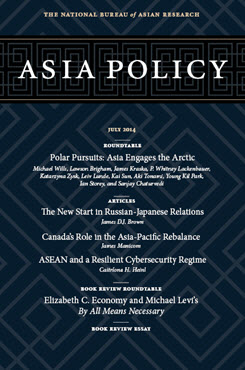The Nordic Embrace
Why the Nordic Countries Welcome Asia to the Arctic Table
This essay is part of the roundtable “Polar Pursuits: Asia Engages the Arctic.”
A range of Asian countries—China, India, Japan, Singapore, and South Korea—were welcomed by the Arctic countries as observers to the Arctic Council in May 2013. This was a controversial decision long resisted by Arctic powers Russia and Canada, with the United States undecided until right before the final decision. The Nordic countries, on the other hand, led by Norway, emphasized the positive aspects of Asia’s interest and saw the region’s greater participation in Arctic affairs as strengthening governance and making the Arctic Council a more relevant and future-oriented forum.
This essay examines the Nordic countries—Denmark (including Greenland), Finland, Iceland, Norway, and Sweden—as Arctic nations and describes their Arctic geography, identity, and economic, political, and security interests. It then seeks to explain the Nordic countries’ basically positive attitude toward Asian involvement in the Arctic, while also identifying the limits and elements of skepticism that still exist. In concluding, the essay looks into the future and discusses challenges and opportunities for the Nordic countries arising from increased Asian ventures into Arctic lands and waters.
Nordic Arctic Interests
There are commonalities as well as differences in the Nordic countries’ Arctic interests. The commonalities among the Nordic states are most striking: history, geography, culture, trade, and politics today knit them closely together such that they cooperate intimately in Nordic as well as international institutions. Sweden and Norway fought a brief war in 1814 and were on the verge of war as recently as 1905. Yet despite this history, as well as their different experiences during World War II and varying security alliances to date, the Nordic countries enjoy strong and peaceful cooperation along virtually every thinkable dimension.
Yet one of the surprises meeting the Asian countries in their quest for Nordic support for their participation in the Arctic Council was the relative lack of a formal Arctic identity in the Nordic region. Arctic politics is decided in the capitals located far south of the Arctic, and there are no Arctic budgets or regional planning units in national ministries. Even the small minority of indigenous peoples in the high north (mainly the Saami people) pay their taxes to the national governments, and the majority of the Arctic Nordic populations view themselves primarily as national citizens rather than Arctic citizens in any significant sense.
Nevertheless, the Arctic matters a lot to the Nordic countries, and increasingly so in the wake of growing global attention to the region’s affairs. A potentially important difference between these states stems from Norway and Iceland not being members of the European Union (EU). Back in May 2013, for example, the admittance of the five Asian countries to the Arctic Council hung in the balance partly due to a spat between the EU (also an applicant for a formal observer role) and Canada over seal hunting. Canada is furious at the EU for boycotting Canadian sealskin production, which is seen as a traditional custom and important business opportunity in Canada’s Arctic region. Although the Nordic EU members found this spat frustratingly difficult and were skeptical of some of the EU’s reasoning, they had to align with Brussels. For this and other reasons, Norway became a major broker in Kiruna, ensuring that a decision was made. The Asian countries, along with Italy, were accepted as formal observers, while the EU still must wait in the wings for some hard-won concessions from intransigent Canada—the current Arctic Council president.
The differences among the Nordic countries—which again are moderate and should be seen in a holistic context—are mainly due to three factors:
Geography. Some Nordic countries are Arctic coastal states, while others are not.
Economy. The level of economic activity and interest in the Arctic differs significantly among the Nordic countries.
Political and security alliances. Norway and Iceland are outside the EU, while Finland and Sweden remain outside NATO.
Norway is by most definitions the most important Nordic Arctic country, trailing only Russia in global Arctic significance. Mainland Norway includes considerable land, coast, and ocean areas that reside north of the Arctic Circle, and Svalbard, an archipelago far north and halfway toward the North Pole, adds to the country’s Arctic identity. Norway already extracts large volumes of oil and gas from Arctic waters, and Norwegian oil and oil service companies are active on Russia’s Arctic continental shelf. Ice melt in the polar region opens new opportunities for the world’s…
About Asia Policy
Asia Policy is a peer-reviewed scholarly journal presenting policy-relevant academic research on the Asia-Pacific that draws clear and concise conclusions useful to today’s policymakers. Asia Policy is published quarterly in January, April, July, and October and accepts submissions on a rolling basis. Learn more


